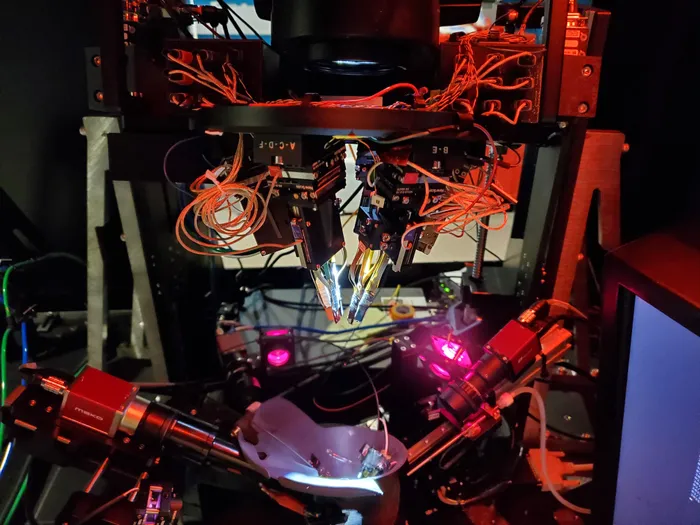Origins of hallucinations traced to specialized brain cells

Researchers used lasers to record and stimulate the activity of neurons in mice in order to learn how the brain processes and interprets optical illusions.
Image: Allen Institute
Mark Johnson
Jo Kavaliauskas once saw human bodies hanging from a meat hook, an image so real they could escape it only by shutting their eyes and going to sleep on the couch. Aliens and demons sometimes appear through the windows, leaving Kavaliauskas terrified to go outside. At 34, they endure the daily hallucinations caused by schizoaffective disorder but dream of a life without them, how it would feel to thrive in a career and make friends with ease.
Now, science appears to be a step closer to understanding how the brain generates hallucinations like Kavaliauskas’s, raising hopes that someday they might be preventable, according to the authors of a study published recently in the journal Nature Neuroscience.
Researchers from the University of California at Berkeley and the Allen Institute in Seattle used lasers to record and stimulate the activity of neurons in mice in order to learn how the brain processes and interprets optical illusions. Their study may also have applications to artificial intelligence, helping researchers to examine whether machine vision systems can perceive illusions in the same way that humans do, said Hyeyoung Shin, the paper’s lead author.

Researchers involved in the study include, top row from left: Hillel Adesnik, Hyeyoung Shin and Lamiae Abdeladim. Bottom row: Mora Ogando, Uday Jagadisan and Jérôme Lecoq.
Image: Allen Institute
Scientists carried out the study by inserting tiny electrodes into the brains of mice ― each brain about the size of a pea ― and recording the way the brain cells talked to each other.
“With these electrodes, we recorded neurons in a similar way to how astronomers would watch thousands of stars in the sky,” said Jérôme Lecoq, one of the authors of the paper and an associate investigator at the Allen Institute. “Picture that you’re looking at these stars but there’s transmission lines between them and you have to think each star is connected to 10,000 other stars.”
The stars in the analogy are actually neurons in the brain, the cells that send electrical and chemical signals through the body, allowing the brain and other organs to communicate.
The new study illuminated the role played by a very select group of neurons. In the visual cortex, the area of the brain that receives and processes information from the eye’s retina, there are specialized cells that use the information they receive to fill in information that is missing, constructing reality rather than simply passively receiving it.
The process works a little like the algorithms that try to anticipate the word we want to type after only a few letters. The cells, known as IC-encoder neurons, fill in missing information, allowing the brain to complete the shapes and patterns in an optical illusion.
One example is the illusion known as the Kanizsa triangle. In one version of the illusion, three Pac-Man-like figures mark the corners of a triangle. Our brains perceive the full triangle even though there are no solid lines marking the triangle’s sides.
Although it is too early to make predictions about possible treatments of schizophrenia, Shin said that if the pattern-completing circuits in the brain become active at the wrong moment, this may help trigger hallucinations.
In that case, one strategy to prevent hallucinations might be to identify and suppress the neurons involved in pattern completion.
Shin and her colleagues discovered the behavior of the IC-encoder neurons by showing mice illusory images like the Kanizsa triangle and recording their brain activity.
The scientists then stimulated the IC-encoder neurons using a second laser, but this time without showing the mice the illusion. They found that the mice displayed the same brain activity as if they had been shown the illusion.
Illusions and hallucinations are not the same. Illusions occur when the brain perceives something different from the image the eyes see, while hallucinations come about because “the brain is completely making up something that isn’t there,” explained Shin, who worked at UC-Berkeley but has since moved to the School of Biological Sciences at Seoul National University.
Shin said that although the paper is primarily a study of how perception works, “it does obviously have implications for any mental [health] disorder where perception is affected.”
Dileep George, a research scientist at Google who did not participate in the Nature Neuroscience study, said the researchers “asked the right questions and were able to do some pretty amazing experiments in mice.”
In an email, George explained, “Our brains predict what we’ll see, and to avoid confusion, they need to keep a clear separation between those predictions, the actual sensations and our final belief about reality. Any cross-talk can result in the brain believing its predictions [are] reality.”
George, has studied and worked on models of visual perception. He showed in one paper that is possible to develop computer models that can trick the blurry text CAPTCHAs, which website visitors must solve to prove they’re human.
Tai Sing Lee, a professor of computer science and neuroscience at Carnegie Mellon University who was not involved in the paper, said “what is remarkable about the study is all of the modern tools they use to elucidate” the communications between the higher and lower levels of the brain involved in processing what we see.
Lee said he can envision the study helping to advance the treatment of vision problems by boosting our understanding “of how the brain allows us to see the world.”
Seeing hallucinations is more common than some might think. A 2021 study in the British Journal of Psychiatry found that hallucinations varied by age from a high of 7 percent in people ages 16 to 19 to a low of 3 percent in people age 70 or over. According to the paper, hallucinations were associated with an increased risk for mental disorders.
The hallucinations experienced by people with schizophrenia and schizoaffective disorder include sounds as well as images, and they’re not always shocking and nightmarish.
Michelle Hammer a 37-year-old mental health advocate in New York who was diagnosed with schizophrenia at 22, said that sometimes she would be sitting at her desk working and see a face.
“But it’s not totally real, 100 percent there,” Hammer said. “It’s more like seeing someone in your peripheral vision. But I’ll completely start talking to [the person], not realizing that I’m doing it until somebody kind of says, ‘What are you doing?’”
Existing medications, she said, “just make it bearable.”
Hammer said other people sometimes see her making a strange face, and she will try to make it clear that ‘I wasn’t actually looking at you.’
“But mostly I just shrug it off, because this is like New York City,” she said. “If you see me talking to myself it’s not the weirdest thing you are going to see all day, you know?”